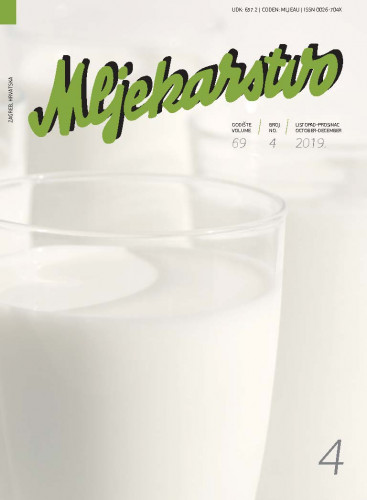In the present study fatty acid (FA) composition in four main groups of dairy products was determined to investigate their development during processing and storage. Fresh cheese, sour cream, butter, and ultra-high temperature (UHT) milk representing differences in technological approach were chosen for the study. Fatty acids methyl esters (FAME) were quantified using a gas chromatograph (GC) equipped with a mass spectrometer (MS) and a capillary column SP-2560. The concentrations and profile of FA in final products were primarily dependent on the FA content of raw milk for UHT milk and fresh cheese production or in the raw cream for sour cream and butter. The shelf life had a significant impact (P<0.05) only in UHT milk and butter, whereby unsaturated fatty acids (UFA) and polyunsaturated fatty acids (PUFA) decreased significantly in UHT milk, while PUFA decreased significantly in butter.; U ovom je radu u četiri glavne vrste mliječnih proizvoda utvrđivan sastav masnih kiselina (FA), kao i njihov udio tijekom prerade i čuvanja. Kako bi se utvrdio utjecaj tehnološkog postupka, za istraživanje su odabrani svježi sir, kiselo vrhnje, maslac i trajno mlijeko obrađeno režimom UHT toplinske obrade. Metilni esteri masnih kiselina (FAME) određeni su pomoću plinskog kromatografa (GC) opremljenog masenim detektorom (MS) i kapilarnom kolonom SP-2560. Koncentracije i profil FA u krajnjim proizvodima su prije svega ovisili o koncentraciji FA u sirovom mlijeku prije UHT obrade mlijeka ili proizvodnje svježeg sira, odnosno o udjelima FA u svježem siru i sirovom vrhnju. Rok trajanja imao je značajan utjecaj (P<0,05) samo u UHT obrađenom mlijeku i u maslacu gdje je utvrđen pad koncentracije nezasićenih (UFA - samo mlijeko) i višestrukonezasićenih (PUFA - mlijeko i maslac) masnih kiselina.
Sažetak

 Mljekarstvo.com : časopis za unaprjeđenje proizvodnje i prerade mlijeka 69,4(2019) / glavna i odgovorna urednica, editor in chief Rajka Božanić.
Mljekarstvo.com : časopis za unaprjeđenje proizvodnje i prerade mlijeka 69,4(2019) / glavna i odgovorna urednica, editor in chief Rajka Božanić.